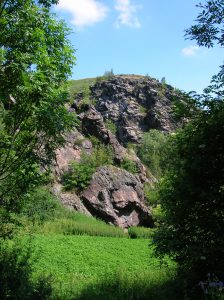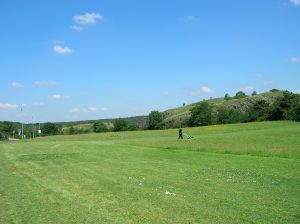Divoká Šárka Park
By Tracy A. Burns
Brilliant Nature
 Romantic cliffs loom above as poetic pastures, flanked by woodlands, stretch into the horizon. Imposing cliff faces line one side of a path as a gurgling brook follows the trail. A tranquil symphony by Antonín Dvořák or Bedřich Smetana should be playing in the background as visitors explore Šárka Park, free of charge and made up of Divoká (Wild) Šárka and Tichá (Silent) Šárka. Unlike Prague’s Waldstein Park or Petřín, here it is a rugged, untamed beauty that astounds. The entrance to Šarecká Valley is through a narrow passageway between Kozákova Rock and Šestákova Rock. Similar narrow passageways, rock formations, rocky walls, cliffs, and a valley shaped like a canyon punctuate Divoká Šárka as do vast meadows. One large rock formation that will awe visitors is called Dívčí Skok (Maiden Leap), which is near a pool where Prague residents often take refuge from the summer heat. The water reservoir Džbán (Jug), one kilometer in length and 200 meters wide with a depth of 7.5 meters, is perfect for skating in the winter and for water sports, such as swimming, in the summer. The Litovický stream winds through almost 20 kilometers. Tichá Šárka, on the other hand, offers a magnificent view of Saint Matěj Church in the Podbaba area and is home to three former mills dating from the 16th century. The Kalinův flour mill was even in operation until
Romantic cliffs loom above as poetic pastures, flanked by woodlands, stretch into the horizon. Imposing cliff faces line one side of a path as a gurgling brook follows the trail. A tranquil symphony by Antonín Dvořák or Bedřich Smetana should be playing in the background as visitors explore Šárka Park, free of charge and made up of Divoká (Wild) Šárka and Tichá (Silent) Šárka. Unlike Prague’s Waldstein Park or Petřín, here it is a rugged, untamed beauty that astounds. The entrance to Šarecká Valley is through a narrow passageway between Kozákova Rock and Šestákova Rock. Similar narrow passageways, rock formations, rocky walls, cliffs, and a valley shaped like a canyon punctuate Divoká Šárka as do vast meadows. One large rock formation that will awe visitors is called Dívčí Skok (Maiden Leap), which is near a pool where Prague residents often take refuge from the summer heat. The water reservoir Džbán (Jug), one kilometer in length and 200 meters wide with a depth of 7.5 meters, is perfect for skating in the winter and for water sports, such as swimming, in the summer. The Litovický stream winds through almost 20 kilometers. Tichá Šárka, on the other hand, offers a magnificent view of Saint Matěj Church in the Podbaba area and is home to three former mills dating from the 16th century. The Kalinův flour mill was even in operation until
From Botany to Birdwatching
Geologists, botanists, and birdwatchers would have a field day here. More than 80 kinds of birds inhabit the parkland. Fishes and reptiles are no strangers, either. Botany enthusiasts will appreciate the fern art, porcupine grass, wavy hair-grass, and oak wood with heather. Various types of trees abound: Oak, beech, pine, ash, lime, birch, and maple trees all make stunning appearances. Other sights in the park include a former cherry orchard, a summer house, a playground, a well, a restaurant, a snack bar, and places offering fantastic views. A unique trait of the park is its natural, open amphitheater, which can hold up to 10,000 spectators. Put into operation before World War I, the amphitheater was used as the National Theatre’s summer stage from 1913 to 1922. Since 2005, on the first Sunday in September, annual operas have been staged here. Rusalka and The Bartered Bride have been just a few of those performed here, and in 2010 the amphitheater was the setting for Libuše. Watching a traditional Czech opera in an open, natural setting can be a thrill, indeed. Well-marked paths meander through the park owned by the City of Prague. Cyclists and joggers can enjoy the scenery as well. Visitors will gaze with awe at the natural wonders of this perfect getaway





